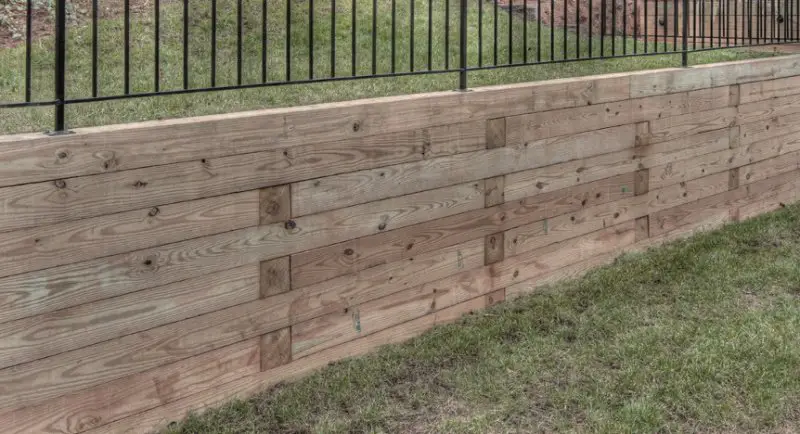
Sometimes you can’t prevent nature from running its course, but you can better prepare for it.
Retaining walls are generally used to stabilize sloped landscapes and to create level surfaces on inclines.
This then allows you to plant plants in your landscape without having to worry about incidences of the soil running down.
Why Use Wood For a Retaining Wall?
Wooden retaining walls continue to be a popular choice among homeowners not only because of the natural look they provide but because of their relatively affordable price point.
Besides stabilizing sloped landscapes, a wooden retaining wall creates an impressive natural charm that can make your landscape incredibly visually appealing.
Wood is a stunning material and is a fantastic way to add decorative flair to any garden or home.
As far as durability is concerned, if properly treated and well-maintained, wooden retaining walls are highly durable and can last for an extended period.
Research shows that a wooden wall, if well built using proper materials, preservatives, and waterproofing can potentially last for at least twenty years.
Issues with Wood Timber Retaining Walls
The main problem with wood timber retaining walls is that the wood itself is subject to rot because it is directly in contact with the soil and moisture.
This vulnerability ultimately shortens the overall lifespan of wooden walls at a rate faster than concrete or block walls.
To help boost the longevity of a timber retaining wall, you need to pay lots of attention to water, where it finally collects and pools both behind and on top of your retaining wall.
This accumulation of water accelerates the decomposition of timber.
So what’s the best wood for a retaining wall?
While it’s possible to chemically treat timber used in retaining walls to make them more waterproof, there is a general concern about those chemicals leaching into the surrounding soil.
For this reason, the best wood material for retaining walls should be naturally resistant to rot.
What’s more, their chemical composition should make them resistant to both fungal and insect pests.
Here are some of the best wood species suitable for making retaining walls.
Cedar
Cedar is arguably the most common timber used for retaining walls.
Cedar contains numerous natural oils that make it highly resistant to damage caused by water, decay, or pests.
This amazing timber is an especially strong wood choice and is not prone to sagging or warping.
It also boasts small, insulating pockets of air inside its grain which protect it against changes in temperature.
It is also relatively affordable and easy to maintain.
Aesthetically, if you want your retaining wall to have a rustic look and exceptional durability, red cedar is the way to go.
Cypress
Cypress is a highly durable, stable wood that is moderately strong and hard.
It’s also rot- and water-resistant, a combination that makes it suitable for heavy constructions, including retaining walls.
It is not only very durable, but easily worked with machine tools and hands.
It also sands and finishes fairly well.
Its golden hues make it a highly attractive choice as well.
Cypress also resists warping.
Redwood
Redwood is a fantastic softwood that boasts impressive qualities that make it a popular choice for outdoor applications.
Redwood’s premium color and grain are attractive even in an unfinished state, but more appealing is its pronounced resistance to both insects and decay.
It is also less prone to warping and cracking due to moisture compared to other softwood species.
What’s more, its natural hue and grain are not only eye-catching but sometimes darken with time.
Redwood also boasts desirable insulating properties.
This incredible timber also takes paint and varnish quite well, which means your finishing options are nearly endless.
Teak
Teak is another timber option you can consider.
It’s a highly versatile wood that can be used for a number of applications thanks to its resistance, color, durability, and soft aroma.
It boasts waterproofing properties which makes it perfect for outdoor use.
It’s resistant to heat and light, and also has natural oils that make it highly resistant to insects as well as other harmful agents, further enhancing its durability.
How to Build a Wood Timber Retaining Wall
To leave you off, here’s a video guide for building a wood retaining wall that will help you get started on your project.
Good Luck!
